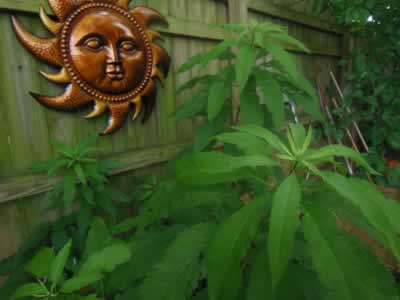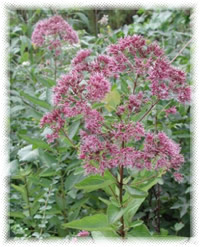Joe-pye weed Eupatorium purpureum
- Common Names
- Joe-pye weed , Gravel or kidney root, Trumpet weed, purple or tall boneset
- Botanical Name
- Eupatorium purpureum
- Family
- ASTERACEAE
Medicinal Uses & Benefits of Joe-pye Weed
Side Effects | Plant & Garden|
- Medicinal Uses: * Kidney
- Properties: * Anti-inflammatory * Bitter * Cathartic * Diuretic * emetic * Febrifuge * Nervine
- Parts Used: Rhizome and roots
- Constituents: flavonoids (including eupatorin), volatile oil, resin
How to Use: Joe-pye weed
Preparation Methods & Dosage :
Joe-pye weed Side Effects: No longer recommended in pregnancy
Plant Description

Joe Pye weed
- Flowers: Pale or dull magenta or lavender pink, slightly fragrant, of tubular florets only, very numerous,in large, terminal, loose, compound clusters, generally elongated. Several series of pink overlapping bracts form the oblong involucre from which the tubular floret and its protruding fringe of style-branches arise.
- Stem:3 to 10 ft. high, green or purplish, leafy, usually branching toward top.
- Leaves:In whorls of 3 to 6 (usually 4), oval to lance-shaped, saw-edged, petioled, thin, rough.
- Preferred Habitat:Moist soil, meadows, woods, low ground.
- Flowering Season:August - September
- Distribution:New Brunswick to the Gulf of Mexico, westward to Manitoba and Texas.
Towering above the surrounding vegetation of low-lying meadows, this vigorous composite spreads clusters of soft, fringy bloom that, however deep or pale of tint, are ever conspicuous advertisements, even when the golden-rods, sunflowers, and asters enter into close competition for insect trade. Slight fragrance, which to the delicate perception of butterflies is doubtless heavy enough, the florets' color and slender tubular form indicate an adaptation to them, and they are by far the most abundant visitors, which is not to say that long-tongued bees and flies never reach the nectar and transfer pollen, for they do. But an excellent place for the butterfly collector to carry his net is to a patch of Joe-Pye Weed in September. Joe-Pye, an Indian medicine-man of New England, earned fame and fortune by curing typhus fever and other horrors with decoctions made from this plant.
Netje Blanchan Wild Flowers worth Knowing(1917)











